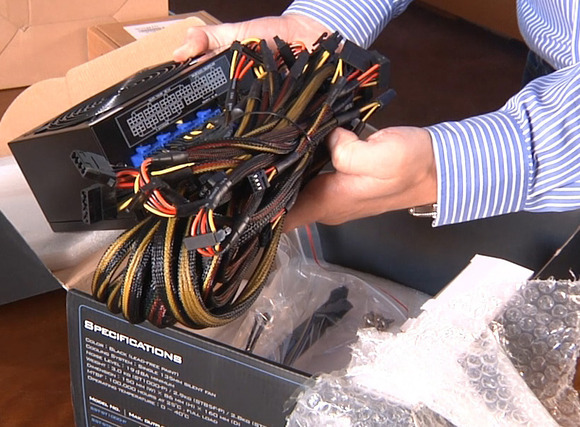Overall, UPS manufacturers tend to overstate the actual power consumption of PCs. A modern PC with a Core i7 920 and a graphics card like midrange HD 5770 consumes about 300W at low load. Even if you overclock the Core i7 920 to 4 GHz and use a high-end graphics card like a HD 5850 or 5870, it will remain below the 500W. With a slower processor, the power consumption is even lower: a PC equipped with a Core i5 661 and a HD 5770 consumes about 80W at minimal load (idle on the Windows desktop) and 220W at full load (3D games). In general, a PSU with real power of 400W is sufficient for all entry-level PC, 500/550W is enough for a midrange PC, and 650W is enough for a high-end PC (without SLI or CrossFire).
Indeed, modern CPUs consume less power because their transistors are getting smaller (45 nm for Penryn and Lynnfield, 32 nm for Clarkdale). New graphics cards are also more efficient, the HD 5770 consumes just 90W under full load, less than a HD 4850! But premium graphics cards can be very inefficient, especially the GTX 400 series: the GTX 480 alone can consume up to 300W! It is therefore useful to know what power supply to choose when you upgrade your graphics card.
It is advisable to choose a PSU from reputable manufacturer, at present, some commercial brands better meet their consumers’ requirements than others.
We can roughly divide PSU brand into 3 groups:
- Manufacturers who sell under their own name (rare).
- Companies that design the products, but assign other company to manufacture them.
- Companies that sell OEM products, they use stock PSU but adding their own label, box and manual.
To avoid any unpleasant surprises, it is better to rely on review sites and computer magazines, when deciding on model and brand to buy.
Should we take a very powerful PSU, to give us a margin in case of a change in configuration or rather, should we go closer to the estimated PC consumption? In fact, the best choice is to strike a balance between the two. We must first determine the maximum power needed by the PC by using tools like Power Supply Calculator (PSC).
Then you must determine the right power supply capacity in order to optimize the power usage on full- and minimal load. Ideally, if we know the minimal consumption, on the Windows desktop, most of the time it corresponds to 20% of the total power needed.
Connectors
Most PSUs have 24-pin ATX 12V connector to the motherboard that is used to power the CPU. However, high performance graphics cards require 6 or 8 pins connectors, due to larger power consumption needed by the GPU, although adapters are supplied with the graphic cards, it is better to choose a PSU that comes with an integrated power connector for high-end graphic cards.
Often after changing video card or CPU, people wonder if their current PSU is sufficient.
You need to read the label on one side of the PSU and we know how much current it provides, for example, the PSU may provide 33A on +12 V. It means that the PSU can offer a maximum combined wattage of 396W (33A multiplied with +12V). You can add up power requirements of your components to determine your maximum power requirement.
Power Factor Correction (PFC)
It is an important indicator, which indicates PSU’s ability to withstand electrical disturbance. When a power supply is cut, a strong high frequencies (harmonics) is generated, along with a phase shift between voltage and current (cos φ between 0.5 and 0.6).
In general, there are two solutions to deal with electrical disturbance:
- The simplest is large coils placed in series: they’re passive PFC solution, which is effective for dealing with minor disturbances.
- The second solution is a small electronic circuit, which is better at dealing with electrical fluctuations.
An active PFC is preferable to a passive type, because with active PFC:
- The resultant waveform is very close to sinusoidal and the remaining harmonics are very low: as the result computer components are much less affected to disturbances.
- The phase shift between voltage and current is almost zero (cos φ close to 1).
Ripple
The PSU should in theory provide a continuous stream of power, in practice, there is always a ripple at high frequency. This ripple is harmful to electronic devices and must be minimized.
Standard ATX could have about 120mV of ripple at full load on the +12 V, but a good PSU shouldn’t exceed 60mV, the best PSU may have lower than 25/30mV of ripple.
Noise
Some power supplies are silent even at minimal load. In general, PSUs with 120mm fan are quieter than the 80mm fan, but that’s not always. Some models use generic fan and therefore quite noisy. Unfortunately, comparative review on power supplies noise is quite rare. PSU with 44 dB of noise is considered very low, at above 45 dB the noise is barely perceptible, while more than 50 dB is considered as noisy.
























